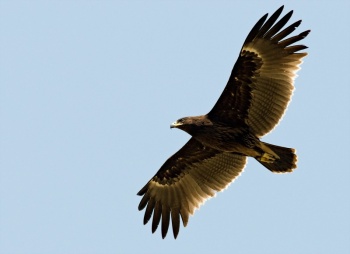(genus change (Clements and IOC)) |
m |
||
| Line 7: | Line 7: | ||
====Similar Species==== | ====Similar Species==== | ||
| − | Other | + | Other eagles, especially [[Lesser Spotted Eagle]] and [[Steppe Eagle]]. |
[[Image:Greater Spotted Eagle-flight.jpg|thumb|350px|right|Photo by {{user|tombac|tombac}}<br />Petcaburi, [[Thailand]], Feb. 2010<br />Click on image to view larger version]] | [[Image:Greater Spotted Eagle-flight.jpg|thumb|350px|right|Photo by {{user|tombac|tombac}}<br />Petcaburi, [[Thailand]], Feb. 2010<br />Click on image to view larger version]] | ||
Revision as of 11:34, 3 February 2013
- Clanga clanga
Identification
Overall a dark bird, except for the "fulvescens" variant (rare) that has body feathers and coverts pale buff but flight feathers and tail normal.
In flight look for a prominent hand with relatively long "finger", including 7th primary, and for underwing coverts darker than underside of flight feathers. On the upperside, there is a pale spot on the base of the primaries and on the base of the tail.
On the close up, look for rounded nostril
Similar Species
Other eagles, especially Lesser Spotted Eagle and Steppe Eagle.
Distribution
Eurasia and Africa. Breeds from northern European Russia south to Ukraine and east across Asia to the Pacific coast of the Russian Far East and eastern China. In Europe very rare outside Russia but small numbers breed in eastern Poland, northern Romania, Moldova and Belarus. Has bred in Sweden and Finland, Estonia and Lithuania, Hungary, Slovenia and Yugoslavia, Israel and Jordan.
Most western birds winter in sub-Saharan Africa but also in northern Greece and Turkey, the Middle East and Egypt. Also occurs in very small numbers in the Po Valley of Italy and southern France, especially the Camargue, in winter.
Undergoes a broad-front migration in September-October and does not concentrate at the major migration stations. Return movement in March-April. Regularly wanders to south-east Sweden, Denmark and sometimes the Netherlands in autumn and winter but not seen in Britain since the early 20th Century.
A vagrant to Norway, west to Iberia, the Balearic Islands and Morocco, also recorded as a vagrant in Sardinia. Also winters from Iran to Pakistan and throughout most of India and in South-East Asia south to southern Burma and Thailand. A vagrant to Malaya.
Taxonomy
This is a monotypic species1.
Formerly included in the genus Aquila.
Habitat
Breeds in large forests with lakes and swamps, open meadows or heath. Sometimes in more open areas but usually near water.
Behaviour
Vocalisation
<flashmp3>Aquila clanga (song).mp3</flashmp3>
Listen in an external program
References
- Clements, JF. 2009. The Clements Checklist of Birds of the World. 6th ed., with updates to December 2009. Ithaca: Cornell Univ. Press. ISBN 978-0801445019.





